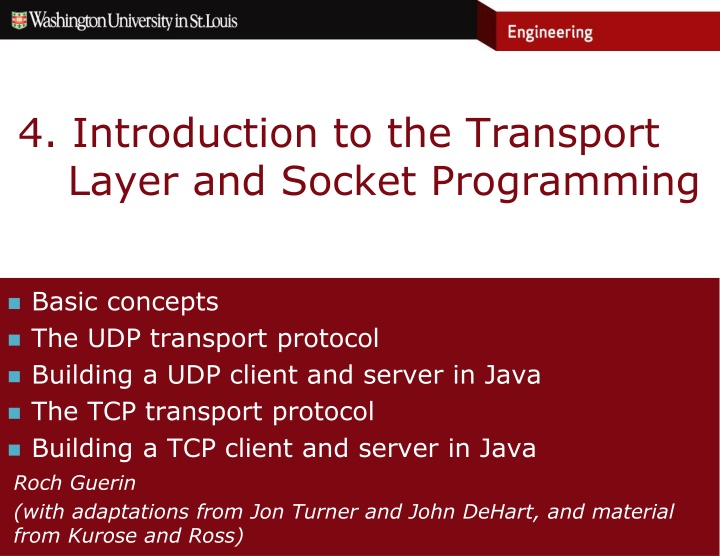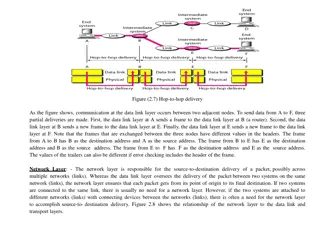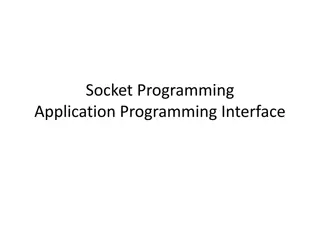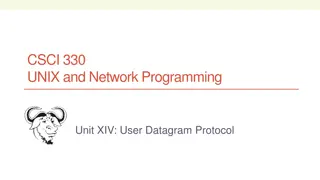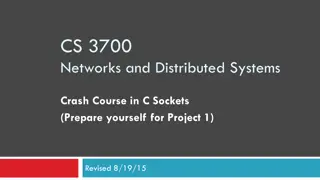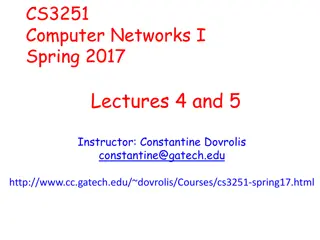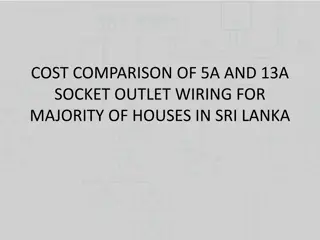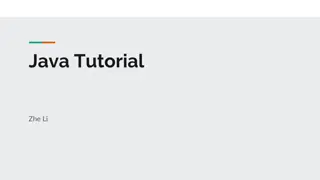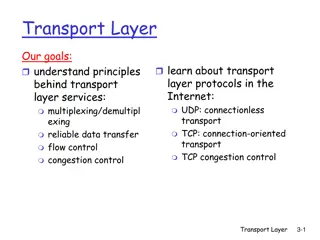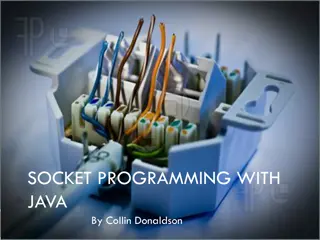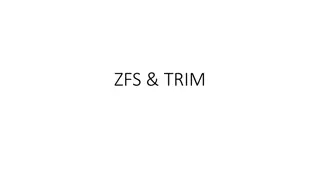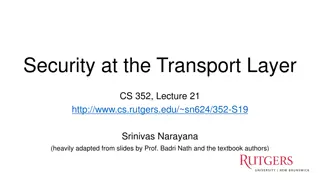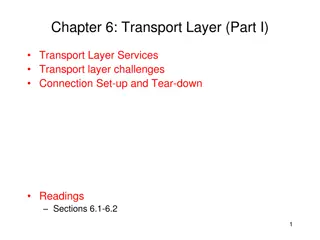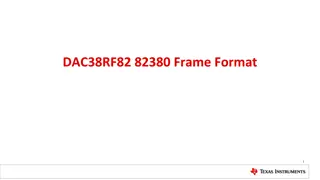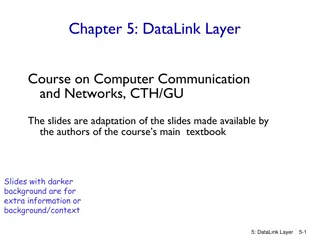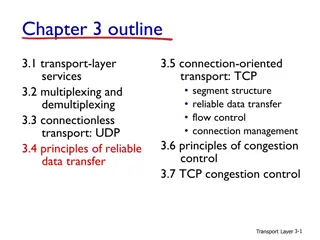Introduction to the Transport Layer and Socket Programming
This content covers basic concepts of the transport layer, UDP and TCP transport protocols, building UDP and TCP clients and servers in Java, Internet essentials, transport services and protocols, and transport layer (de)multiplexing. It explains how sockets and port numbers are used for communication between hosts, the characteristics of UDP and TCP protocols, and the role of transport layer in data transmission.
Download Presentation

Please find below an Image/Link to download the presentation.
The content on the website is provided AS IS for your information and personal use only. It may not be sold, licensed, or shared on other websites without obtaining consent from the author.If you encounter any issues during the download, it is possible that the publisher has removed the file from their server.
You are allowed to download the files provided on this website for personal or commercial use, subject to the condition that they are used lawfully. All files are the property of their respective owners.
The content on the website is provided AS IS for your information and personal use only. It may not be sold, licensed, or shared on other websites without obtaining consent from the author.
E N D
Presentation Transcript
4. Introduction to the Transport Layer and Socket Programming Basic concepts The UDP transport protocol Building a UDP client and server in Java The TCP transport protocol Building a TCP client and server in Java Roch Guerin (with adaptations from Jon Turner and John DeHart, and material from Kurose and Ross)
Internet Essentials process router p2 ... p1 host socket network stack IP select socket using port# packet address 1.2.3.4 sp dp sa da ports addresses Routers forward packets among hosts Internet Protocol (IP) provides best-effort delivery of datagram packets based on addresses in packet headers Processes use sockets as interface to network stack Transport protocols define port numbers used to identify specific sockets 2
Transport Services and Protocols Transport services enable communication between application processes running on different hosts most basic function is extending packet delivery inside hosts in the Internet, port numbers are used for this purpose The network is mostly oblivious to transport level information Though some network devices (NATs and firewalls) can modify/act on transport information Two principal transport protocols in Internet UDP provides datagram interface and some limited error detection Client code is aware of packet/datagram TCP provides byte-stream interface, reliable data transport, flow control, congestion control Client code has no notion of packet neither provides bandwidth or delay guarantees since the Internet (typically) does not 3
Transport Layer (De)Multiplexing Multiplexing, i.e., combining over shared resource Transport connections share the same IP address Port numbers identify individual programs (allow them to share the same IP address) running programs communicate through sockets and transport protocol software maps port numbers to sockets Connectionless (de)multiplexing (UDP) to send packet to a remote program, must know the port number it is using, in addition to its host s IP address when a UDP packet arrives at a host, the destination port # is used to identify the socket that is to receive the packet the destination port is the only information used to identify socket 1 socket can receive packets from multiple different remote hosts source IP address and port # of received packet used to reply to individual senders 4
UDP Details 16 bits 16 bits Port numbers are 16 bits long Length specifies number of bytes in UDP segment , including header Checksum is used to detect errors in UDP segment sender computes checksum by adding 16 bit chunks (keep adding beyond 16 bits) On overflow, add carry bits back to 16 bits value Take one s complement (change 0/1 to 1/0) receiver checks for errors by re-computing sum and comparing to value in packet since IP runs over multiple different link layer protocols, it cannot rely on link layer for error detection even though link layer routinely implements error detection src port dst port length checksum application data 5
Ones Complement Arithmetic A: 0000 1000 1000 1001 B:1000 0000 0001 0001 C: 1001 1111 0001 1111
Ones Complement Arithmetic A: 0000 1000 1000 1001 B:1000 0000 0001 0001 C: 1001 1111 0001 1111 A+B+C: A: 0000 1000 1000 1001 +B:1000 0000 0001 0001 = 1000 1000 1001 1010
Ones Complement Arithmetic A: 0000 1000 1000 1001 B:1000 0000 0001 0001 C: 1001 1111 0001 1111 A+B+C: A: 0000 1000 1000 1001 +B:1000 0000 0001 0001 = 1000 1000 1001 1010 +C:1001 1111 0001 1111 =10010011110111001 + 0001 = 0010011110111010
Ones Complement Arithmetic A: 0000 1000 1000 1001 B:1000 0000 0001 0001 C: 1001 1111 0001 1111 A+B+C: A: 0000 1000 1000 1001 +B:1000 0000 0001 0001 = 1000 1000 1001 1010 +C:1001 1111 0001 1111 =10010011110111001 + 0001 = 0010011110111010 = 1101100001000101 (one s complement)
Resources for Java Online Calvert and Donahoo book TCP/IP SOCKETS IN JAVA Available from ScienceDirect through Wash. U. Library http://www.sciencedirect.com/science/article/pii/B9781558606852500108 Or order your own copy from Amazon Google it! If I want to know about methods of the DatagramPacket class I google Java DatagramPacket Methods First listing there is great: http://download.java.net/jdk7/archive/b123/docs/api/java/net/Datag ramPacket.html
Simple UDP Echo Server in Java import java.io.*; import java.net.*; public class UdpServer { public static void main(String args[]) throws Exception { // open datagram socket on port 9876 DatagramSocket sock = new DatagramSocket(9876); // create two packets sharing a common buffer byte[] buf = new byte[1000]; DatagramPacket inPkt = new DatagramPacket(buf, buf.length); DatagramPacket outPkt = new DatagramPacket(buf, buf.length); while (true) { // wait for incoming packet sock.receive(inPkt); // set address, port and length fields of outPkt // so as to return contents of inPkt to sender outPkt.setAddress(inPkt.getAddress()); outPkt.setPort(inPkt.getPort()); outPkt.setLength(inPkt.getLength()); // and send it back sock.send(outPkt); } } } 11
UDP Echo Client import java.io.*; import java.net.*; public class UdpClient { public static void main(String args[]) throws Exception { // get server address and open socket InetAddress serverAdr = InetAddress.getByName(args[0]); DatagramSocket sock = new DatagramSocket(); // build packet addressed to server, then send it byte[] outBuf = args[1].getBytes("US-ASCII"); DatagramPacket outPkt = new DatagramPacket(outBuf,outBuf.length,serverAdr,9876); sock.send(outPkt); // create buffer and packet for reply, then receive it byte[] inBuf = new byte[1000]; DatagramPacket inPkt = new DatagramPacket(inBuf,inBuf.length); sock.receive(inPkt); // print buffer contents and close socket String reply = new String(inBuf,0,inPkt.getLength(),"US-ASCII"); System.out.println(reply); sock.close(); } } 12
Recap of Classes/Methods Used DatagramSocket (defined in java.net) used to read/write packets opened by constructor, closed using close() method UDP socket only has local machine address/port # DatagramPacket (in java.net) defines packet with payload defined by array of bytes in Java, a byte is not the same thing as a char encode strings as bytes using String s getBytes method with a specified encoding convert byte arrays to Strings using String constructor with specified encoding address and port fields specify peer address/port length field is # of bytes to send in packet, or # received InetAddress (in java.net) use static method getByName(addressString) to convert a destination host s name to its internet address (DNS!!!) 13
Key TCP Concepts To provide reliable communication, the TCP networking software at both communicating hosts must cooperate requires information that must be maintained consistently at both ends to allow the network software to initialize this information, communicating processes must first establish a connection Two kinds of sockets in TCP listening socket used by server to make itself available for connection requests any host in the internet can send a connection request to a listening socket (assuming it knows the IP address and port#) connection socket used by a client-server pair to exchange data identified by 4-tuple : local address/port#, remote address/port# server can have multiple connection sockets using same port# typically, each connection socket handled by separate thread 14
TCP Connection Establishment open socket and configure as listening socket accept (and wait) open Socket and connect connection socket opened source address, port associated with socket connection established now connected 15
TCP Echo Server import java.io.*; import java.net.*; public class TcpServer { public static void main(String args[]) throws Exception { // create listen socket and buffer ServerSocket listenSock = new ServerSocket(6789); byte[] buf = new byte[1000]; while (true) { // wait for connection request; create connection socket Socket connSock = listenSock.accept(); // create buffered versions of socket's in/out streams BufferedInputStream in = new BufferedInputStream( BufferedOutputStream out = new BufferedOutputStream( while (true) { // read and echo until peer closes int nbytes = in.read(buf, 0, buf.length); if (nbytes < 0) break; out.write(buf,0,nbytes); out.flush(); } connSock.close(); } } } connSock.getInputStream()); connSock.getOutputStream()); 16
TCP Echo Client import java.io.*; import java.net.*; public class TcpClient { public static void main(String args[]) throws Exception { // open socket and connect to server Socket sock = new Socket(args[0], 6789); // create buffered reader & writer for socket's in/out streams BufferedReader in = new BufferedReader(new InputStreamReader( sock.getInputStream(),"US-ASCII")); BufferedWriter out = new BufferedWriter(new OutputStreamWriter( sock.getOutputStream(),"US-ASCII")); // output second argument to server, adding a newline // as delimiter; flush all data from buffer to network out.write(args[1]); out.newLine(); out.flush(); } } // read data up to end of line and close connection System.out.println(in.readLine()); sock.close(); 17
Additional Classes/Methods Used SEE CHAPTER 3 OF CALVERT & DONAHOO ServerSocket (in java.net) used to listen for incoming connection requests Socket (in java.net) used for (TCP) connection sockets associated input and output streams for transferring bytes BufferedInputStream/BufferedOutputStream (in java.io) buffers bytes in user space for more efficient data transfers InputStreamReader/OutputStreamWriter (in java.io) for converting between bytes and chars/Strings can use variety of encoding methods BufferedReader/BufferedWriter (in java.io) buffers chars in user space for more efficient transfers readLine() method simplifies parsing of input 18
Issues with Byte Stream Interface reads take bytes from socket buffer writes add bytes to socket buffer sender receiver TCP TCP packets formed independently of writes Bytes that are written together may not be transferred together, so don t expect single read to get them all If receiver is slow to read bytes receiver s socket buffer fills, causing it to flow-control sender when sender s socket buffer fills, additional writes block, suspending application program bytes are transferred as space becomes available at receiver 19
Another (Formatting) Issue with Byte Streams Since no visible packet boundaries (unlike datagrams), sending program must format data to assist receiver For character data, common technique is to use newline character (or CR,LF pair) as delimiter receiver reads complete lines, then parses contents of each line For binary data, simplest approach is fixed format receiver relies on pre-arranged format when reading data can send a variable length array by first sending a length field receiver first reads length, then reads as many additional items as specified by the length field Many other possibilities, but there must be some well- defined format that receiver can depend on Basically, defining an application protocol! 20
Network and Host Byte Orders SEE CHAPTER 3 OF CALVERT & DONAHOO Two common conventions for representing multi-byte values in a computer s memory little-endian low order byte comes first in memory so 32 bit hex value 0xabcdef12 is stored 12, ef, cd, ab big-endian high order byte comes first Internet protocols assume high-order byte sent first to ensure this, may need to reformat data before sending a packet (and after receiving it) Java provides mechanisms to handle this automatically DataInputStream/DataOutputStream (in java.io) for TCP sockets declare by wrapping BufferedInputStream/OutputStream DataInputStream in = new DataInputStream( new BufferedInputStream(connSock.getInputStream())); use provided methods to write/read binary data, e.g., int i = in.readInt(); float x; out.writeFloat(x); ByteBuffers (in java.nio) for UDP sockets 21
TCP Segment Format 16 bits 16 bits src port dst port Port numbers are 16 bits long Length specifies number of 32 bit words in TCP header (typically 5) Flags include (among others): SYN and FIN bits used to setup and teardown connections Checksum is used to detect errors in TCP segment sender computes checksum by adding 16 bit chunks on arithmetic overflow, sum is incremented receiver re-computes sum and compares to value in packet Defer discussion of other fields sequence # acknowledgment # Length - recv window flags checksum urgent data options application data 22
Exercises 1. What services does TCP provide that UDP does not? 1. Name three services that neither UDP nor TCP provide. 1. Suppose a host is running two programs A and B that both communicate over the internet using UDP. If the socket for program A is mapped to port number 6789, is it possible for the socket for program B to also be mapped to port number 6789? 1. When a UDP server receives a packet from a client program and replies to the client, how does it know where to send the packet? 23
Exercises -- Solutions 1. What services does TCP provide that UDP does not? Reliable data transport, flow control, congestion control 2. Name three services that neither UDP nor TCP provide. Security, rate guarantee, delay guarantee 3. Suppose a host is running two programs A and B that both communicate over the internet using UDP. If the socket for program A is mapped to port number 6789, is it possible for the socket for program B to also be mapped to port number 6789? No 4. When a UDP server receives a packet from a client program and replies to the client, how does it know where to send the packet? Src address and src port 24
Exercises 5. Assume a UDP payload that consists of the 6 bytes on the previous slide. Can you change one bit without changing the checksum? What about 2 bits? Can you generalize this result? A: 0000 1000 1000 1001 B:1000 0001 0001 0001 C: 1001 1110 0001 1111 25
Exercises 5. Assume a UDP payload that consists of the 6 bytes on the previous slide. Can you change one bit without changing the checksum? What about 2 bits? Can you generalize this result? A: 0000 1000 1000 1001 B:1000 0001 0001 0001 C: 1001 1110 0001 1111 A one bit change will change the checksum. A two bit change may be undetectable. Multi-bit errors may not be detected. 26
Checksum Error Detection Failure A: 0000 1000 1000 1001 B:1000 0000 0001 0001 C: 1001 1111 0001 1111 A+B+C: A: 0000 1000 1000 1001 +B:1000 0000 0001 0001 = 1000 1000 1001 1010 +C:1001 1111 0001 1111 =10010011110111001 + 0001 = 0010011110111010 = 1101100001000101 A: 0000 1000 1000 1001 B:1000 0001 0001 0001 C: 1001 1110 0001 1111 A+B= 1000 1001 1001 1010 +C:1001 1110 0001 1111 10010011110111001 + 0001 = 0010011110111010 = 1101100001000101
Exercises 6. How many sockets does a UDP server need to communicate with 100 remote clients concurrently? How many port numbers does it need? 28
Exercises 6. How many sockets does a UDP server need to communicate with 100 remote clients concurrently? How many port numbers does it need? 1 and 1 29
Exercises 7. How many sockets does a TCP server need to communicate with 100 remote clients concurrently? How many port numbers does it need? 8. How does the network stack identify the socket to which an incoming TCP data packet is to be delivered? 30
Exercises 7. How many sockets does a TCP server need to communicate with 100 remote clients concurrently? How many port numbers does it need? 101 (1 listening socket and one socket per active client) 1 port number is sufficient, as client sockets are identified by the 4-tuple (SA,SP,DA,DP) 8. How does the network stack identify the socket to which an incoming TCP data packet is to be delivered? as stated above, connection sockets are identified by the 4-tuple (SA,SP,DA,DP) 31
